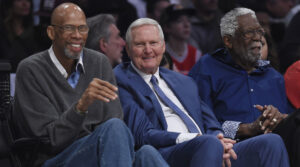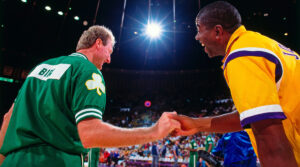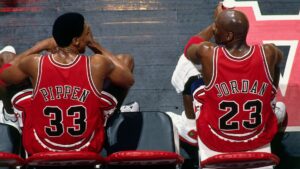Before we get into these starting 5’s from each decade, let me point out a disclaimer. I am not going with the traditional PG-SG-SF-PF-C lineup. Rather I am electing to go backcourt and frontcourt players. The main reason being the lack of centers in the 2010’s but also to build the most dominant lineup we can.
Pre-1980’s
Since basketball pre 1980’s is seen as almost a different sport, I have combined those decades together.
The backcourt of Oscar Robertson and Jerry West should be no surprise. Both players dominated their positions in their era and remain legendary names even 50 years since they last played. West and Robertson were elite at both scoring and facilitating, combining for a dynamic backcourt duo.
The front court comes with a bit more debate. At the Small Forward spot, or should I say wing spot, it came down to Elgin Baylor or John Havlicek. While Havlicek was more of a facilitator and could score at ease, I went with Baylor. Not only is he a better scorer and more athletic, but he could grab rebounds at a high rate despite his short stature.
The other two vacancies come down to 3 names. Bill Russell, Wilt Chamberlain, and Kareem Abdul-Jabbar. Do we go with Russell’s 11 rings and defense, or do we go with Wilt Chamberlain’s pure dominance? Can we leave Kareem off the all decade team when he was the best player out of the 3?
After arguing with myself, I came to the decision of leaving Wilt Chamberlain off the list. The deciding factor in all of these all time debates is winning. Russell is the ultimate winner. Kareem was the best all around player, and won more than Chamberlain. Also with the West, Robertson and Baylor all on the short side, Russell and Kareem’s defense is needed more than Wilt’s dominant offense.
PG: Oscar Robertson: 25.7 points, 9.5 assists, 7.5 rebounds
SG: Jerry West: 27.0 points, 5.8 rebounds, 6.7 assists
SF: Elgin Baylor: 27.4 points, 13.5 rebounds, 4.3 assists
PF: Bill Russell: 15.1 points, 22.5 rebounds, 4.3 assists
C: Kareem Abdul-Jabbar: 28.6 points, 14.8 rebounds, 4.5 assists
1980’s
The 1980’s is the decade where the NBA became a top tier sport. It escaped the drug issues and bad image it obtained in the 70’s and entered new heights.
This of course was on the backs of a rivalry between two men, Magic Johnson and Larry Bird. The two were polar opposites as people, yet eerily similar players. Magic ran the show in Los Angeles, while Bird steered the ship the Celtics way. The two dominated the decade, winning a total of 7 NBA Championships, and 6 MVP Awards. Lock these two in the starting 5.
The other backcourt slot goes to a young but still dominant Michael Jordan. When you think MJ, you associate him with the 90’s and the Bulls dynasty. But from the moment he arrived in Chicago, Jordan was coming for the top spot. He averaged 28.2 points per game in his rookie season, and he was just getting warmed up. By the end of the decade, Jordan was a MVP and Defensive Player of the Year.
The front court to pair with Bird is a tough decision. At the center position we could have gone with Kareem, like we did for the previous team. In the 80’s, he won four titles and made nine All-Star games. However, Kareem’s pure dominance was not what it was in the 70’s. It sounds crazy to say that a guy averaging over 20 points for a decade isn’t dominant. But by the 86-87 season, Kareem had seen a steady decline.
So to show love to another big man from the decade, I give the spot to Moses Malone. Malone captured two MVP awards and a Finals MVP during the decade, while leading the league in rebounds by more than 1,000 boards over the second place player.
For the final spot in the starting 5 of the decade, it came down to a few guys. Charles Barkley, Dominique Wilkins, and Julius Erving. Barkley had not yet hit his prime, and Dr. J was no longer in his prime. And to be completely honest, I would just love to see Jordan and Wilkins running the wing on a fast break with Magic handling the ball. But Wilkins also fits the criteria. He was in his peak, twice averaging 30 plus points in a season, and making the all star team five times in the decade.
PG: Magic Johnson: 19.9 points, 11.7 assists, 7.3 rebounds
SG: Michael Jordan: 32.8 points, 6.3 rebounds, 6.0 assists
SF: Dominique Wilkins: 26.1 points, 6.7 rebounds, 2.4 assists
PF: Larry Bird: 24.9 points, 10.1 rebounds, 6.3 assists
C: Moses Malone: 24.5 points, 13.2 rebounds, 1.5 assists
1990’s
The 90’s were dominated by the Chicago Bulls, as they won 6 titles and grew the sport to international levels. With that said Michael Jordan and Scottie Pippen are locks in this decade starting 5.
The team that dominated between the Bulls two 3-peats, was the Houston Rockets. They were led by Hakeem Olajuwon, who won two Defensive Player of the Year Awards, one league MVP and 2 Finals MVPs in the decade. Sure there were other centers like Shaq, Ewing, and David Robinson, but none of them were as good as Hakeem in the 90’s.
To run the offense at, the options were rather slim. Isiah Thomas was better in the 80’s, than he was in the 90’s. Penny Hardaway didn’t play all of the decade. John Stockton is the only true option when you take into account his stats, his 2 finals appearances and longevity.
The final spot comes down to two candidates, Charles Barkley and Karl Malone. In many ways their careers are parallels, both started in the 80’s, peaked in the 90’s and are ringless because of Michael Jordan. Malone has the better career numbers, and had a longer career. Malone made two finals compared to Barkley’s one final appearance. Malone’s numbers across the decade are more impressive than Barkley, and has one more MVP. But I’m going with Barkley to complete the starting 5. The decision came down to me just liking Barkley, and the fact that Karl Malone is a garbage human being. If you don’t know, just google the man.
PG: John Stockton: 14.4 points, 11.3 assists, 2.2 steals
SG: Michael Jordan: 30.3 points, 6.2 rebounds, 4.9 assists
SF: Scottie Pippen: 18.8 points, 7.1 rebounds, 5.8 assists
PF: Charles Barkley: 21.7 points, 11.5 rebounds, 4.2 assists
C: Hakeem Olajuwon: 23.0 points, 10.9 rebounds, 3.2 blocks
2000’s
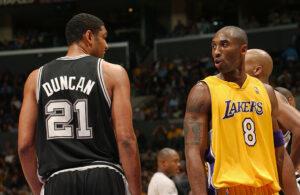
We have some obvious locks in this starting 5, including Kobe at the shooting guard position, Shaq at center, and LeBron at the small forward position. Kobe won 4 titles in the decade, a league MVP, and a scoring title. Shaq won a league MVP, 4 titles, and dominated the first half of the decade. LeBron, who didn’t even reach his peak during the decade, is the clear choice at the forward position. I could go into detail about all three but their resumes speak for itself.
There could be some debate at the power forward spot between Duncan, Garnett and Dirk. Duncan is the easy answer for me, but out of respect to the other two legends, they deserved the shoutout.
The only true debate to be had with the starting 5 of the 2000’s is at the point guard position. Jason Kidd was the best all around at the position. Allen Iverson was the most influential and gifted offensive player. Steve Nash won 2 league MVP’s during the decade that featured a prime Shaq, Kobe, Duncan, Dirk, and Garnett. Whether you agree that he deserved them or not, we can’t just erase history because we disagree with it. So the two MVP awards give Nash the nod in this discussion.
PG: Steve Nash: 16.8 points, 9.6 assists, almost 50-40-90 averages
SG: Kobe Bryant: 28.5 points, 5.8 rebounds, 5.2 assists
SF: Lebron James: 27.8 points, 7.0 rebounds, 7.0 assists
PF: Tim Duncan: 20.9 points, 11.5 rebounds, 2.3 blocks
C: Shaquille O’Neal: 21.3 points, 9.9 rebounds, 2.0 blocks
2010’s
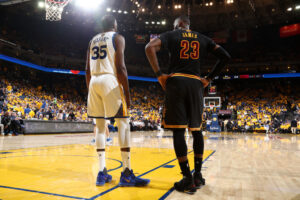
To be completely transparent, the first four spots of the 2010’s starting 5 was easy to determine. Steph Curry is the greatest shooter the league has ever seen, first unanimous league MVP, and a 3x champion. The other guard is James Harden was the decades most prolific scorer, oh and he developed into an elite facilitator in Mike D’Antoni’s system.
Lebron James obviously lands one of the front court spots as he dominated the decade, making 8 of the NBA Finals. Kevin Durant also finds his way into the starting 5 as he was the second best player in the decade behind LeBron. The four of them combined for 6 league MVP’s, 33 All-Star selections and 29 All-NBA selections in the decade.
The final spot in this starting 5 was difficult to decide. It is the only decade that doesn’t have the prototypical dominat center. If I were to stick to the traditional position, it would have come down to just okay options. We had a half decade of good but not prime Dwight Howard. Guys like Joel Embiid, Nikola Jokic, and Anthony Davis have not put together a long enough career or accomplished enough to just give them the top spot.
Marc Gasol was probably the most qualified as he played at a high level for most of the decade, and led the Grizzlies to a conference finals appearance, and won a ring with Toronto. But do we ever associate greatness with Marc Gasol?
So to avoid having a weak link in the starting 5, I adopted the frontcourt and backcourt way of deciding who gets the nod. This left me with a few options. Draymond Green played the center position in the “Death” lineup for the Warriors while winning 3 rings. We could slide James Harden to the 3 and run out Westbrook at the 2. But ultimately Kawhi Leonard grabs the fifth spot for this all decade starting 5.
Leonard won 2 rings, 2 Finals MVP’s, and 2 Defensive Player of the Year Awards during the decade. When healthy he battles for the best player in the league title. For sure he has been the best two way player in the league for some time now.
PG: Steph Curry: 24.3 points, 6.7 assists, 43.5% from 3 point range
SG : James Harden: 26.6 points, 6.7 assists, 5.5 rebounds
SF: Kawhi Leonard: 18.6 points, 6.4 rebounds, 1.8 steals
F: Lebron James: 26.5 points, 7.7 rebounds, 7.7 assists
F: Kevin Durant: 27.7 points, 7.4 rebounds, 1.2 blocks
